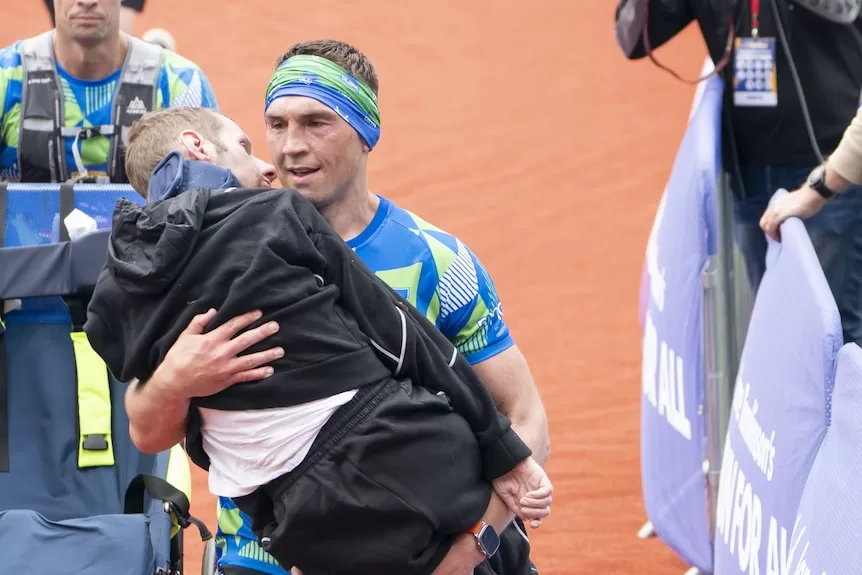Aboriginal and Torres Strait Islander readers are advised that this article contains the name and images of an Indigenous person who has died.
Motor neurone disease (MND) is an uncommon and rapidly progressing neurological disease affecting the brain and nerves.
Former England and Leeds Rhinos rugby league player Rob Burrow, who was diagnosed with MND in 2019, died aged 41 on Sunday.
He raised millions for the community and research, bravely sharing his journey with the public.
So, what are the symptoms of MND are is there a link between the disease and contact sport?
What are the first signs of MND?
Symptoms of MND may not be obvious at first but early warning signs include muscle weakness in your hands, feet or voice.
Examples of early symptoms are:
- Slurred speech
- A weak grip
- Muscle cramps or twitches
- Weakness in legs, causing you to trip
- Weight loss
- Difficulty to stop laughing or crying at inappropriate situations
The disease progresses and later on people become very weak.
They have little or no movement and have trouble talking, breathing and swallowing.
What causes MND?
MND is caused by a problem with cells in the brain and nerves called motor neurons.
These cells gradually stop working over time but it is not known why this happens.
Having a close relative with MND, or a related condition called frontotemporal dementia, can sometimes mean you’re more likely to get it.
But it does not run in families in most cases.
A combination of environmental, lifestyle and genetic factors are also believed to have an impact.
How long can you live with it?
Life expectancy after being diagnosed with MND is one to five years, but it can vary from person to person.
An estimated 10 per cent of people living with the disease survive for 10 years or more.
What are the treatments and is there a cure?
There is no current cure for MND but treatments are available to help lessen the impact on a person’s quality of life.
Treatments include:
- A medicine called riluzole that can slightly slow down the progression of the condition
- Medicines to relieve muscle stiffness and help with saliva problems
- Physiotherapy
- Speech therapy
- Occupational therapy
- Advice from dietitians
Are MND and ALS the same?
MND is an umbrella term for a group of diseases that affect motor neurons, Amyotrophic Lateral Sclerosis (ALS) is the most common form of MND.
Other forms include:
- Progressive bulbar palsy
- Progressive muscular atrophy
- MND with frontal temporal dementia
- Primary lateral sclerosis
Is there a link between MND and contact sport?
Several high profile rugby union and league players have been diagnosed with the disease.
Burrow announced his retirement in 2017 and bravely shared his health journey to raise awareness of MND.
In November 2022, Scotland rugby international player Doddie Weir died aged 52, after an MND diagnosis in 2016.
Australian rugby league forward Carl Webb passed away aged 42 in December 2023.
The list, sadly, goes on. So is there a link?
A 2022 study at the University of Glasgow concluded a group of former Scottish international rugby players were 15 times more likely to develop MND than the general population.
In findings published in the Journal of Neurology, Neurosurgery and Psychiatry, researchers found that the players group had an approximately two and a half times higher risk of neurodegenerative disease than expected but that player position had no impact on risk.
Brian Dickie, director of research development at the Motor Neurone Disease Association, said the findings added weight to previous reports on increased risk in soccer players but said as a “considerably smaller” study, there were questions around it.
“For example, it is not clear exactly how many players were diagnosed with MND, though from the information provided, that absolute number will be small,” he said.
“It is also surprising that there were no cases reported in the larger control group, as MND is the most common neurodegenerative disease of mid-life.
“Moreover, we know that the vast majority of cases of MND involve a complex mix of genetic and environmental risk factors, so the level of genetic risk may be different in high performance athletes compared with the general population.
“What is clear is that this research needs to be extended into much larger populations, which will require close collaboration between researchers and rugby representative bodies across multiple countries.”
What are Australians doing to raise awareness?
FightMND’s Big Freeze will be held at the Melbourne Cricket Ground on Monday, June 10, as part of the King’s Birthday clash between Melbourne and Collingwood.
It is the 10th consecutive year of the event, which was launched to support former AFL player Neale Daniher and all those affected by MND.
Daniher was diagnosed with MND in 2013 and he is co-founder and patron of FightMND.
During the fundraising event, celebrities slide into a pool of ice water.
